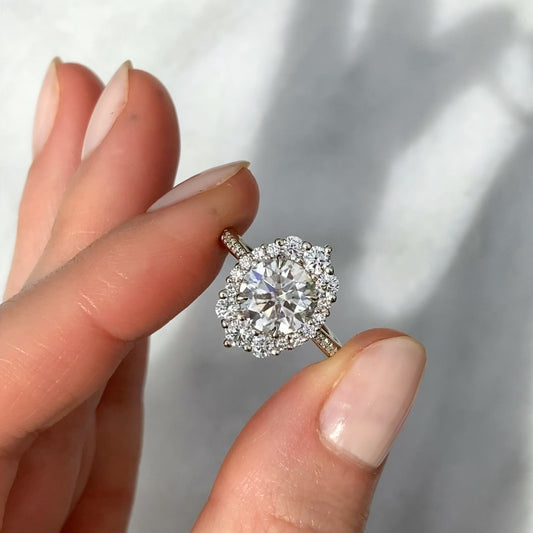
Zafiro Blanco vs Diamante: A Comparison of Beauty, Value, and Lab-Grown Diamonds
When it comes to choosing a gemstone for engagement rings, jewelry, or other precious accessories, two options often come to the forefront: the “zafiro blanco” (white sapphire) and the diamondBoth stones are beautiful, durable, and prized for their brillianceHowever, they each offer distinct qualities that can make one more suitable than the other depending on your needs and preferencesIn this article, we’ll explore the differences and similarities between zafiro blanco vs diamante, including the rise of lab-grown diamonds, to help you make an informed choice.
Zafiro Blanco: The Alluring White Sapphire
The term “zafiro blanco” refers to a white sapphire, a variety of sapphire that is colorless or nearly colorlessSapphires, which are naturally occurring corundum gemstones, come in many colors, but the white variety is prized for its elegance and understated beautyHere are some key features of white sapphires:
- Color and Clarity: White sapphires are valued for their clarity and transparency, often compared to diamonds for their similar appearanceHowever, white sapphires tend to have a slightly warmer or creamier hue compared to diamonds’ cooler brilliance.
- Durability: Sapphires are incredibly durable and are rated 9 on the Mohs scale of hardness, just below diamondsThis makes them a good choice for everyday wear and jewelry pieces exposed to regular wear and tear.
- Cost: White sapphires are more affordable than diamonds, making them an attractive option for those on a budgetThey offer a luxurious look without the steep price tag associated with diamonds.
- Brilliance: While white sapphires sparkle beautifully, their brilliance is not quite as intense as that of diamondsThis is due to the differences in how the two stones interact with light.
Diamante: The Timeless Diamond
Diamonds, often referred to as the “king of gemstones,” are prized for their exceptional brilliance, rarity, and cultural significanceHere are the characteristics of diamonds that set them apart from other gemstones:
- Color and Clarity: Diamonds come in a wide range of colors, with the rarest and most valuable being completely colorlessThe diamond’s clarity is also an important factor, with fewer inclusions or imperfections making the stone more valuable.
- Durability: Diamonds are the hardest natural substance on Earth, with a rating of 10 on the Mohs scale of hardnessThis means they are incredibly resistant to scratches and damage, making them perfect for high-impact items like engagement rings that are worn daily.
- Cost: Diamonds are known for their high price, which can be attributed to their rarity, historical significance, and the labor-intensive mining processWhile they are available in a range of sizes and qualities, even a modest diamond can cost significantly more than a white sapphire of similar size and quality.
- Brilliance: The cut of a diamond has a profound impact on its brillianceDiamonds are known for their stunning sparkle, which is a result of their high refractive index and dispersionThe facets of a diamond are cut in such a way to maximize the light that enters and exits the stone, creating a firework-like display of colors.
Lab-Grown Diamonds: A Modern Alternative
In recent years, the popularity of lab grown diamonds has surgedThese diamonds, also known as synthetic or cultured diamonds, are created in laboratories using two primary methods: High Pressure High Temperature (HPHT) and Chemical Vapor Deposition (CVD)They have the same physical, chemical, and optical properties as natural diamonds but are generally more affordable.
Benefits of Lab-Grown Diamonds
- Affordability: Lab-grown diamonds can cost 20-40% less than their mined counterparts, offering the same brilliance and sparkle without the hefty price tag.
- Sustainability: Since lab-grown diamonds are produced in controlled environments, they have a much smaller environmental and ethical footprint compared to mined diamonds, which are associated with significant ecological damage and human rights issues.
- Customization: Lab-grown diamonds allow for a greater degree of customization in terms of size, shape, and quality, as they can be created to precise specifications.
Zafiro Blanco vs Diamante: Key Differences
When comparing zafiro blanco vs diamante, several factors come into play:
- Appearance: Both stones are beautiful, but diamonds are renowned for their superior sparkle and brillianceWhite sapphires, while still dazzling, often have a more subdued, softer sheen.
- Durability: While white sapphires are quite durable, diamonds are the hardest known material, making them ideal for jewelry that will be worn every day.
- Cost: White sapphires are much more affordable than diamonds, making them a great alternative for those looking for a more budget-friendly option without compromising on style.
- Symbolism and Status: Diamonds carry a level of status and symbolism that white sapphires do notFor many, diamonds represent love, commitment, and luxury, especially in engagement ringsWhite sapphires, on the other hand, offer a more understated elegance.
- Environmental and Ethical Considerations: Lab-grown diamonds offer an ethical and sustainable option for those who are concerned about the environmental impact of mining and the social issues surrounding conflict diamondsWhite sapphires are naturally occurring and don’t have the same ethical concerns as diamonds, but they are not quite as rare or culturally significant.
Conclusion: Which Should You Choose?
Choosing between zafiro blanco vs diamante depends on your preferences, priorities, and budgetIf you’re seeking a more affordable alternative to a diamond with similar aesthetic qualities, a white sapphire may be a perfect choiceIf you’re looking for the pinnacle of brilliance, durability, and timeless value, a diamond—whether natural or lab-grown—might be the ideal option.
Lab-grown diamonds also offer a fantastic middle ground, providing the same look and feel as a natural diamond but with fewer ethical and environmental concernsUltimately, each stone has its own unique beauty and value, and your decision should reflect what matters most to you in terms of appearance, symbolism, and sustainability.








